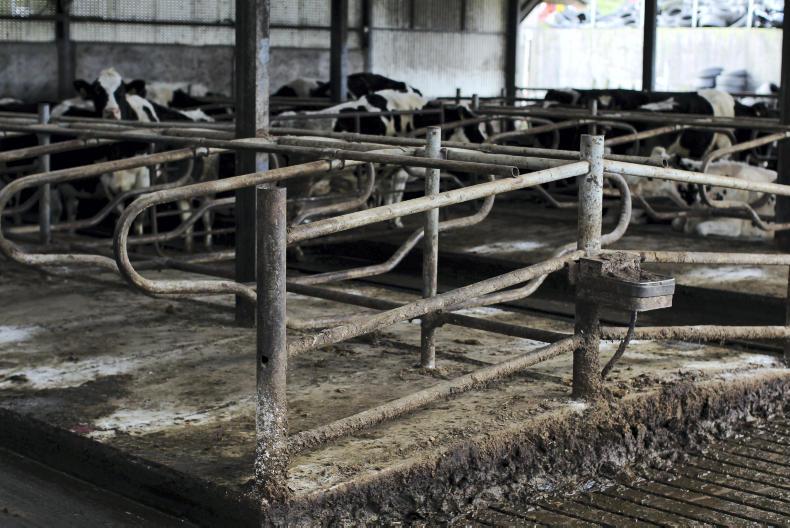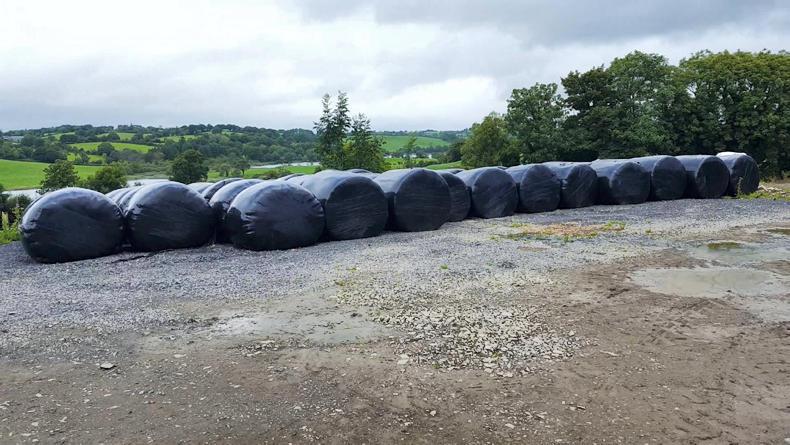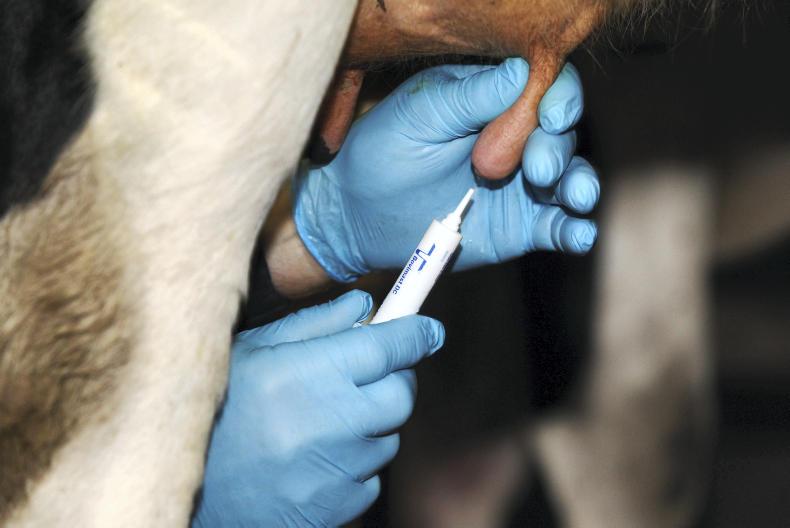The two spring-calving farms on the Dairylink programme are continuing to dry off cows and prepare for a busy calving period beginning in February. Both farms have increased their six-week calving rates over the past three years, meaning calves will drop quicker and demand for grass will rise earlier than in previous years.
On Charles Clarke’s farm, near Bailieborough, Co Cavan, calving is due to start from 10 February and 75 to 80 cows and heifers are expected to calve down in the first three weeks.
Scanning results indicate that calving will be finished on the farm in 10 weeks.
Preparation
Preparation for calving begins on farms long before the first cow is dried off. Managing cow body condition score is an ongoing process throughout lactation and building an adequate supply of grass for spring begins in late summer when plans are made to reach peak average farm cover in mid-September.
 The final grazing round began on Charles’ farm on 26 September and cows were housed full-time on 9 November. Average closing cover was on target at 680kg DM/ha. This should allow early grazing in drier paddocks that are close to the yard shortly after the first cows calve in mid-February.
The final grazing round began on Charles’ farm on 26 September and cows were housed full-time on 9 November. Average closing cover was on target at 680kg DM/ha. This should allow early grazing in drier paddocks that are close to the yard shortly after the first cows calve in mid-February.
A busier calving period will also put additional pressure on labour and space in calf accommodation. Charles will hire additional labour during spring and will sell bull calves and beef-bred calves from late-calving cows as soon as possible to free up room in the calf shed.
Other jobs for the dry period include washing, disinfecting and bedding calving pens and calf accommodation for the spring. Preparing a cashflow budget for the next 12 months is a useful exercise when the workload outside is reduced.
Charles Clarke, Bailieborough,
Co Cavan
 It was generally a good season in terms of cow performance, grass growth and grazing. Average grass growth on this farm in 2017 was 12.8t DM/ha. Cows were out at grass from 15 February and although there was some on-off grazing at the start of the season, all cows had grass in their diet from a week after calving.
It was generally a good season in terms of cow performance, grass growth and grazing. Average grass growth on this farm in 2017 was 12.8t DM/ha. Cows were out at grass from 15 February and although there was some on-off grazing at the start of the season, all cows had grass in their diet from a week after calving.
There were spells of wet weather, with some silage fed in early autumn and cows housed for a few days in August. However, I am pleased that cows were able to stay at grass during the wet autumn.
The aim is to start grazing again on 15 February next year. With more cows calving earlier, there could be pressure on grass supply and so 90 bales of good-quality silage are earmarked for feeding in the spring.
This could be as a buffer feed to bridge gaps in supply and demand, or as the main diet if conditions are wet and cows are housed. These bales were made from excess grazing covers in the early summer and have DMD of over 70%. There is plenty of fodder on the farm for the winter period and silage quantity is not an issue.

Half the herd are dry at present and more will be dried off this week. Cows dried off so far include any cows due to calve before 20 February and a few low body condition score heifers. Overall, body condition across the herd is on target, with most cows at the optimal condition score of 2.75 or 3.
At drying off, all cows get an antibiotic dry cow tube and are teat-sealed. Somatic cell count is generally higher this year, as a few problem cows in the herd have pushed average cell count close to 300,000/ml. Cows also get pour-on for roundworms, lungworms, lice and mites and a triclabendazole drench for ?uke.
Output
Output of milk solids is forecast to be up by around 16% this season compared with 2016. This is due to milk volume forecast to increase by 15%, with more cows milking this year. Milk components are also up slightly from 4.05% butterfat and 3.31% protein in 2016 to a forecast 4.10% and 3.41% respectively this season.
The cost base has not increased significantly over the year and the increased milk output, coupled with improved milk price, means the farm business will be in a better position when the financial performance for 2017 is calculated in the new year.
There are 42 replacement heifers coming forward, with 35 due to calve in the first six weeks to AI bulls. The remainder will calve to an Angus stock bull in the following three weeks.
There are more replacement heifers than I need to maintain cow numbers at around 114 head next season. Stocking rate on the milking platform in 2017 was 3.48 LU/ha and there is not much room to increase this further.
However, all heifers will still join the herd to allow older cows that have lower EBIs, are bigger in size or have lower butterfat and protein levels, to leave. Around 25 in-calf cows will be either culled or sold as springing cows before calving. This is the first year that I have been able to cull based on genetics and production and it should increase both the herd EBI (€59) and butterfat and protein levels.
Read more
All reports from the Dairylink programme
The two spring-calving farms on the Dairylink programme are continuing to dry off cows and prepare for a busy calving period beginning in February. Both farms have increased their six-week calving rates over the past three years, meaning calves will drop quicker and demand for grass will rise earlier than in previous years.
On Charles Clarke’s farm, near Bailieborough, Co Cavan, calving is due to start from 10 February and 75 to 80 cows and heifers are expected to calve down in the first three weeks.
Scanning results indicate that calving will be finished on the farm in 10 weeks.
Preparation
Preparation for calving begins on farms long before the first cow is dried off. Managing cow body condition score is an ongoing process throughout lactation and building an adequate supply of grass for spring begins in late summer when plans are made to reach peak average farm cover in mid-September.
 The final grazing round began on Charles’ farm on 26 September and cows were housed full-time on 9 November. Average closing cover was on target at 680kg DM/ha. This should allow early grazing in drier paddocks that are close to the yard shortly after the first cows calve in mid-February.
The final grazing round began on Charles’ farm on 26 September and cows were housed full-time on 9 November. Average closing cover was on target at 680kg DM/ha. This should allow early grazing in drier paddocks that are close to the yard shortly after the first cows calve in mid-February.
A busier calving period will also put additional pressure on labour and space in calf accommodation. Charles will hire additional labour during spring and will sell bull calves and beef-bred calves from late-calving cows as soon as possible to free up room in the calf shed.
Other jobs for the dry period include washing, disinfecting and bedding calving pens and calf accommodation for the spring. Preparing a cashflow budget for the next 12 months is a useful exercise when the workload outside is reduced.
Charles Clarke, Bailieborough,
Co Cavan
 It was generally a good season in terms of cow performance, grass growth and grazing. Average grass growth on this farm in 2017 was 12.8t DM/ha. Cows were out at grass from 15 February and although there was some on-off grazing at the start of the season, all cows had grass in their diet from a week after calving.
It was generally a good season in terms of cow performance, grass growth and grazing. Average grass growth on this farm in 2017 was 12.8t DM/ha. Cows were out at grass from 15 February and although there was some on-off grazing at the start of the season, all cows had grass in their diet from a week after calving.
There were spells of wet weather, with some silage fed in early autumn and cows housed for a few days in August. However, I am pleased that cows were able to stay at grass during the wet autumn.
The aim is to start grazing again on 15 February next year. With more cows calving earlier, there could be pressure on grass supply and so 90 bales of good-quality silage are earmarked for feeding in the spring.
This could be as a buffer feed to bridge gaps in supply and demand, or as the main diet if conditions are wet and cows are housed. These bales were made from excess grazing covers in the early summer and have DMD of over 70%. There is plenty of fodder on the farm for the winter period and silage quantity is not an issue.

Half the herd are dry at present and more will be dried off this week. Cows dried off so far include any cows due to calve before 20 February and a few low body condition score heifers. Overall, body condition across the herd is on target, with most cows at the optimal condition score of 2.75 or 3.
At drying off, all cows get an antibiotic dry cow tube and are teat-sealed. Somatic cell count is generally higher this year, as a few problem cows in the herd have pushed average cell count close to 300,000/ml. Cows also get pour-on for roundworms, lungworms, lice and mites and a triclabendazole drench for ?uke.
Output
Output of milk solids is forecast to be up by around 16% this season compared with 2016. This is due to milk volume forecast to increase by 15%, with more cows milking this year. Milk components are also up slightly from 4.05% butterfat and 3.31% protein in 2016 to a forecast 4.10% and 3.41% respectively this season.
The cost base has not increased significantly over the year and the increased milk output, coupled with improved milk price, means the farm business will be in a better position when the financial performance for 2017 is calculated in the new year.
There are 42 replacement heifers coming forward, with 35 due to calve in the first six weeks to AI bulls. The remainder will calve to an Angus stock bull in the following three weeks.
There are more replacement heifers than I need to maintain cow numbers at around 114 head next season. Stocking rate on the milking platform in 2017 was 3.48 LU/ha and there is not much room to increase this further.
However, all heifers will still join the herd to allow older cows that have lower EBIs, are bigger in size or have lower butterfat and protein levels, to leave. Around 25 in-calf cows will be either culled or sold as springing cows before calving. This is the first year that I have been able to cull based on genetics and production and it should increase both the herd EBI (€59) and butterfat and protein levels.
Read more
All reports from the Dairylink programme
 The final grazing round began on Charles’ farm on 26 September and cows were housed full-time on 9 November. Average closing cover was on target at 680kg DM/ha. This should allow early grazing in drier paddocks that are close to the yard shortly after the first cows calve in mid-February.
The final grazing round began on Charles’ farm on 26 September and cows were housed full-time on 9 November. Average closing cover was on target at 680kg DM/ha. This should allow early grazing in drier paddocks that are close to the yard shortly after the first cows calve in mid-February.  It was generally a good season in terms of cow performance, grass growth and grazing. Average grass growth on this farm in 2017 was 12.8t DM/ha. Cows were out at grass from 15 February and although there was some on-off grazing at the start of the season, all cows had grass in their diet from a week after calving.
It was generally a good season in terms of cow performance, grass growth and grazing. Average grass growth on this farm in 2017 was 12.8t DM/ha. Cows were out at grass from 15 February and although there was some on-off grazing at the start of the season, all cows had grass in their diet from a week after calving. 






 This is a subscriber-only article
This is a subscriber-only article












SHARING OPTIONS: